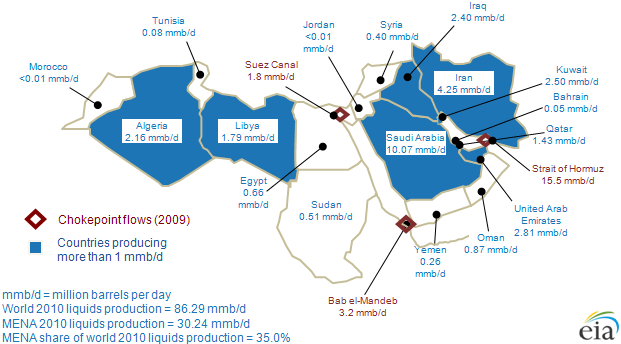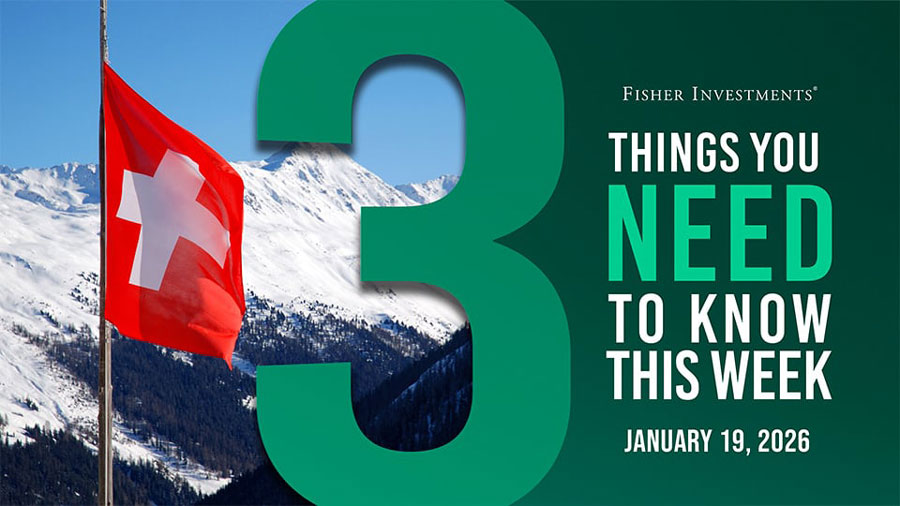Personal Wealth Management /
A MENA Update
A look at what’s currently going on in the MENA conflicts and possible impacts on global oil supplies.
Story Highlights:
- In 2010, Middle Eastern and North African countries supplied about 30 million barrels/day (mmb/d) of liquid fuels, or a little more than one-third of estimated total global production.
- Now, internal conflict in some MENA countries is heightening uncertainty about global oil supply.
- Here we take a look at what’s going on in Libya, Syria, Yemen, Bahrain/Saudi Arabia, and Jordan.
- From a global economic stance, the most stricken MENA countries contribute very little directly to global oil supplies. Additionally, important Saudi Arabian oil supplies don’t seem likely to fall to conflict as of now.
- No doubt uncertainties might be contributing to higher energy prices worldwide for the time being.
Jordan, supplied < 0.01 mmb/d in 2010
- Jordan’s King Abdullah II replaced his cabinet on February 1stand appears to support reforms, urging dialogue between opposition forces and the government.
- Last weekend’s clash between protestors and police resulted in over 100 wounded and the first casualty in the three-month old anti-government protests. Protestors are mostly calling for reform, not overthrowing the government, though anti-government sentiment could escalate as protests wear on.
Yemen, supplied 0.26 mmb/d in 2010
- A protracted standoff between Yemeni President Ali Abdullah Saleh and protestors is increasing instability in the country. Saleh refused to offer more concessions after promises ranging from forming a national unity government to resigning power in 2013 failed to placate the opponents who want immediate resignation.
- Members of Saleh’s regime have defected to the revolution following deadly government assaults on protestors on March 18th. But Saleh warns Yemen would likely deteriorate into civil war between rival tribes, including those supporting al-Qaeda.
The US and Saleh have been partners in the fight against Yemen-based al-Qaeda, and Saleh’s departure could have implications for anti-terrorism efforts. Yemen’s population is roughly split between Sunni and Shiite, so conflict in the country could attract Iranian interest and/or become a source of broader sectarian conflict. Yemen is the 32ndlargest exporter of oil and 16thlargest seller of liquefied natural gas. Currently, Yemen’s ports are still operating normally with no disruptions, despite rising unrest.
Syria, supplied 0.4 mmb/d in 2010
- In concessions to protestors, Syrian President Bashar al-Assad fired his cabinet Tuesday and promised to end emergency laws formally on Wednesday—this remains to be seen. Assad is also expected to announce a new cabinet by the end of the week.
- Since protests erupted March 18th, more than 60 have been killed and hundreds injured as government forces retaliated, though violence has eased in recent days following Assad’s promises. Most protestors are demanding reforms rather than Assad’s resignation, which differentiates the situation from Libya.
Syria has a Sunni majority population (about 75%), but Assad and many in the ruling regime are minority Alawites, a sect of Shiite Islam. The sectarianism has led to social tensions in the country. Syria is currently Iran’s (4.25mmb/d liquid fuels) closest Arab ally and strongly anti-Israel. If the Sunni majority ushers in a new Sunni ruling regime, the new government could undermine Iran’s influence in the region, which wouldn’t be terrible. Syria as an oil producer supplies a relatively small amount of oil, which could easily be offset by current spare capacity.
- Over the weekend, rebel forces seized strategic coastal oil towns and advanced on Sirte, a key government stronghold and gateway to Tripoli, helped by US-led international airstrikes.
- NATO will take command of military operations from the US on Wednesday, but the US will continue to deploy heavily armed, low-flying aircraft against government-led forces.
- About 40 global delegates convened Tuesday in London to discuss Libya’s political future.
- We see three probable outcomes for Libya: 1) Government forces crumble and Gadhafi is killed or captured, and the rebels form a government. 2) Gadhafi’s troops overcome the rebels, and he maintains regime. 3) Indefinite stalemate and/or ongoing civil war.
The first outcome would most likely support an eventual Libyan oil production recovery, while the third would most likely lead to permanent damage to oil infrastructure and a prolonged shutdown. The second outcome might look like Iraq in the 1990s—a heavily embargoed and poorly run oil industry with vastly reduced productivity. Whatever the outcome, a rapid rebound in oil production is unlikely anytime soon. Spare capacity from Saudi Arabia is mitigating Libya’s lost production at this point.
Bahrain, supplied 0.05 mmb/d in 2010 / Saudi Arabia, supplied 10.07 mmb/d in 2010
- Shiite anti-government protestors faced huge setbacks after Saudi Arabia sent Gulf Cooperation Council (GCC) troops into Bahrain to quell protestors and help the government regain civil order.
- Further discord between the Shiite opposition and ruling Sunnis was evident by parliament accepting the resignations of 11 lawmakers from the largest Shiite opposition group, al-Wefaq.
- Al-Wefaq has previously refused to enter talks with the crown prince Sheikh Salman bin Hamad al-Khalifa without concessions but now says it would welcome an offer from Kuwait to mediate talks between opposition groups and the government.
Shiites comprise Bahrain’s majority population, while the royal family and much of the government is Sunni. The biggest risk in Bahrain would be a Shiite/Sunni confrontation pulling in Iran (dominantly Shiite) and Saudi Arabia (dominantly Sunni). Though Shiites are the minority in Saudi Arabia, they heavily populate oil-rich Eastern Arabia, and a Saudi Arabian conflict could threaten Saudi oil supplies, which would almost certainly send global oil prices to record highs. However, the chances of Iranian involvement and/or the spill of sectarian violence into Eastern Arabia seems much reduced, as the presence of Saudi troops in Bahrain seems to have muted opposition forces for now. Additionally, King Abdullah of Saudi Arabia increased social spending by $120 billion since protests began to help placate domestic dissent.
*Source: US Energy Information Administration, https://www.eia.gov/todayinenergy/detail.php?id=690
If you would like to contact the editors responsible for this article, please message MarketMinder directly.
*The content contained in this article represents only the opinions and viewpoints of the Fisher Investments editorial staff.
Get a weekly roundup of our market insights
Sign up for our weekly e-mail newsletter.

You Imagine Your Future. We Help You Get There.
Are you ready to start your journey to a better financial future?

Where Might the Market Go Next?
Confidently tackle the market’s ups and downs with independent research and analysis that tells you where we think stocks are headed—and why.






